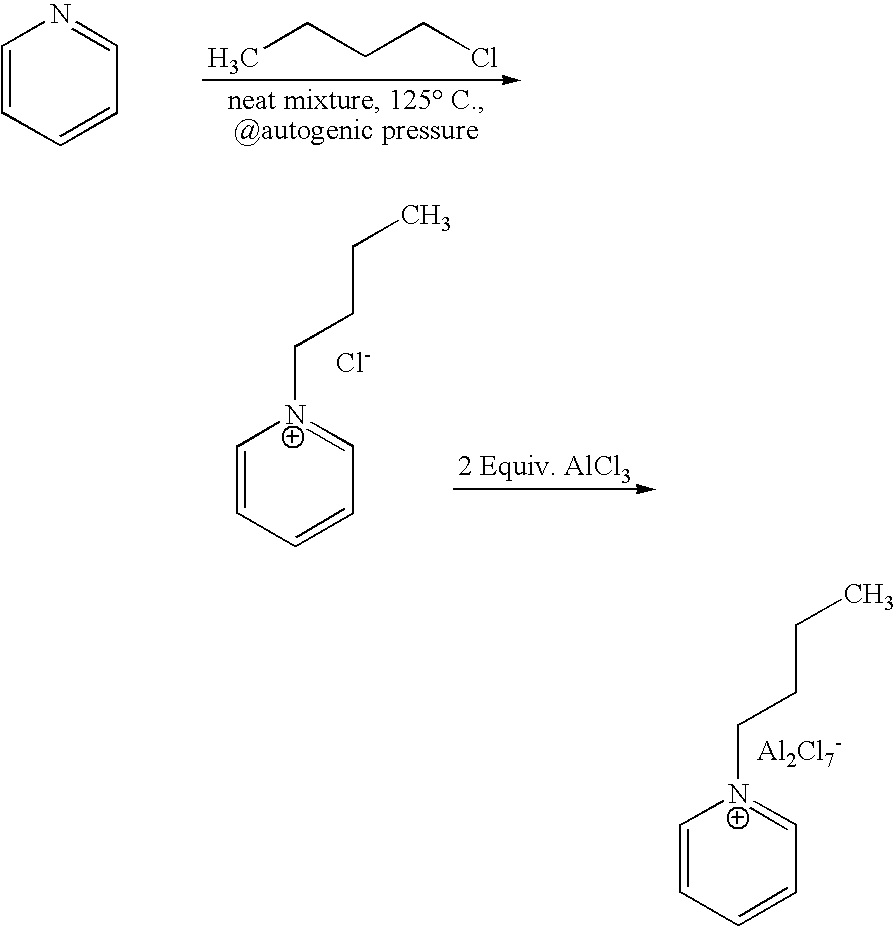Process for making and composition of superior lubricant or lubricant blendstock
a technology of lubricant and blendstock, applied in the direction of hydrocarbon preparation catalysts, hydrocarbon oil treatment products, organic chemistry, etc., can solve the problems of air quality problems in both fuels and lubricants, undesirable olefinic double bonds, and olefins in fuels are also associated with air quality problems, so as to enhance the quality of the desired fuel or lubricant, reduce the concentration of double bonds, and reduce the amount of hydrofinishing
- Summary
- Abstract
- Description
- Claims
- Application Information
AI Technical Summary
Benefits of technology
Problems solved by technology
Method used
Image
Examples
example 1
Preparation of Fresh 1-Butyl-Pyridinium Chloroaluminate Ionic Liquid
[0044]1-butyl-pyridinium chloroaluminate is a room temperature ionic liquid prepared by mixing neat 1-butyl-pyridinium chloride (a solid) with neat solid aluminum trichloride in an inert atmosphere. The syntheses of 1-butyl-pyridinium chloride and the corresponding 1-butyl-pyridinium chloroaluminate are described below. In a 2-L Teflon-lined autoclave, 400 gm (5.05 mol.) anhydrous pyridine (99.9% pure purchased from Aldrich) were mixed with 650 gm (7 mol.) 1-chlorobutane (99.5% pure purchased from Aldrich). The neat mixture was sealed and let to stir at 125° C. under autogenic pressure over night. After cooling off the autoclave and venting it, the reaction mix was diluted and dissolved in chloroform and transferred to a three liter round bottom flask. Concentration of the reaction mixture at reduced pressure on a rotary evaporator (in a hot water bath) to remove excess chloride, un-reacted pyridine and the chlorofo...
example 2
Oligomerization of 1-Decene
[0047]One process for making high quality oils is by oligomerization of olefins followed in a separate step by alkylation with an isoparaffin. Olefin oligomers exhibit good physical lubricating properties. However, introducing short chain branching in the oligomers enhances the properties of the final products. Introducing the branching can be done by alkylation of the oligomers with isoparaffins. Alkylation of the oligomeric products is also a route to reducing the olefinicity of the oligomers and, hence, producing chemically and thermally more stable oligomers. The process is exemplified by alkylation of 1-decene oligomers (described below).
[0048]Oligomerization of 1-decene and alkylation of the oligomer were done according to the procedures described below. In a 300 cc autoclave equipped with an overhead stirrer, 100 gm of 1-decene was mixed in with 20 gm of 1-methyl-tributyl ammonium chloroaluminate. A small amount of HCl (0.35 gm) was introduced to th...
example 3
Alkylations of 1-Decene Oligomers
[0049]The oligomers of 1-decene made as described in example 2 were alkylated with isobutane in 1-butylpyridinium chloroaluminate and in methyl-tributyl ammonium chloroaluminate (TBMA) ionic liquids according to the procedures described below. In a 300 cc autoclave fitted with an overhead stirrer, 26 gm of the oligomer and 102 gm of isobutane were added to 21 gm of methyl-tributyl-ammonium chloroaluminate ionic liquid. To this mixture, 0.3 gm of HCl gas was added and the reaction was heated to 50° C. for 1 hr while stirring at >1000 rpm. Then the reaction was stopped and the products were collected in a similar procedure as described above for the oligomerization reaction. The collected products, colorless oils, have Bromine Number of 3.2. Table 1 shows the SIMDIST analysis of the oligomer alkylation products.
[0050]Alkylation of the oligomer was repeated using the same procedure described above, but 1-butylpyridinium chloroaluminate was used in place...
PUM
| Property | Measurement | Unit |
|---|---|---|
| Viscosity Index | aaaaa | aaaaa |
| yields | aaaaa | aaaaa |
| temperature | aaaaa | aaaaa |
Abstract
Description
Claims
Application Information
 Login to View More
Login to View More - R&D
- Intellectual Property
- Life Sciences
- Materials
- Tech Scout
- Unparalleled Data Quality
- Higher Quality Content
- 60% Fewer Hallucinations
Browse by: Latest US Patents, China's latest patents, Technical Efficacy Thesaurus, Application Domain, Technology Topic, Popular Technical Reports.
© 2025 PatSnap. All rights reserved.Legal|Privacy policy|Modern Slavery Act Transparency Statement|Sitemap|About US| Contact US: help@patsnap.com

